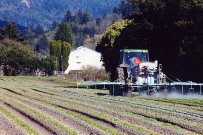Study the Result of Pressure by Siskiyou Land Conservancy

A spray rig applies the fungicides copper hydroxide and chlorothalonil onto lily fields adjacent to Smith River Elementary School.
Scientists at the North Coast Regional Water Quality Control Board have discovered significant pesticide contamination in a stream leading to the Smith River Estuary.
In August 2010, a team from the North Coast Regional Water Quality Board visited the Smith River estuary and sampled water in two streams, two places in each stream (above and below pesticide use). It took a full year, but in August 2011 Water Quality released its chilling results: Copper levels in the sampled water were nearly 28 times higher than the California Toxics Rule allows for freshwater habitat, and “demonstrate evidence of chronic reproductive toxicity,” according to the report, which cites Siskiyou Land Conservancy as the organization that requested the testing. (Copper is a common ingredient in pesticides and is harmful to aquatic life.)
For several years Siskiyou Land Conservancy has pressured Water Quality to test the Smith River estuary and surrounding streams for pesticide residues resulting from lily farming on the Smith River Plain. The recent results indicate that aquatic life in the Smith River, particularly its celebrated salmon and steelhead runs, may be at risk.
Christopher Pincetich, Ph.D., an expert on the effects of pesticides on aquatic organisms, said of the state’s test results, “The chronic toxicity result is very significant; I saw almost zero reproduction. That test uses Ceriodaphnia dubia, a freshwater invertebrate, the ‘water flea.’ It is very relevant to use as it is the base of the food-web. If Cerio can not reproduce in your watershed, you can technically extrapolate this to say that salmon habitat is likely impaired as their food source (small aquatic invertebrates) is impacted.” In late August, Pincetich and Greg King, executive director of Siskiyou Land Conservancy, co-led a panel on pesticides and salmonids at the annual Coho Confab, a statewide conference held this year at Rock Creek Ranch on the South Fork Smith River.
“With results like this, the next step is for Water Quality, state Fish and Game, the state Department of Pesticide Regulation, the National Marine Fisheries Service and U.S. EPA to take a serious look at pesticide use surrounding the Smith River estuary,” said King. “This means more monitoring of streams and soils, and monitoring of air quality as well to protect residents of the nearby town of Smith River. It also means working directly with lily farmers to reduce chemical use. The farmers themselves may hold in their hands the fate of the Smith River’s fabled fish runs.”
The Water Quality Board’s report is potentially bad news for California’s healthiest anadromous fishery. State and federal agencies list the Smith River as a “key watershed” for recovering the West’s salmon, steelhead and cutthroat trout populations. Pesticides can have slow, insidious impacts on aquatic habitat, reducing fish populations and other species over time. Alongside the Smith River estuary, highly toxic pesticides such as metam sodium and 1,3-Dichloropropene are used in per-acre amounts that are higher than anywhere else in California.
Other pesticides used near the estuary are equally alarming. In 2010 the National Marine Fisheries Service released its Endangered Species Act/Section 7 Consultation Biological Opinion for salmonids, identifying 12 pesticides that can directly reduce salmon populations. At least three of these 12 salmon-killing pesticides are used on Smith River lily fields.
Siskiyou Land Conservancy is seeking additional water quality monitoring and enforcement of the Clean Water Act, the Endangered Species Act and recent case law to protect Smith River salmonids. Although government action is slow in coming, the Water Quality Board’s recent monitoring would not have occurred at all had not Siskiyou Land Conservancy pressured the agency. Siskiyou Land Conservancy remains the only organization working to reduce pesticide use on lily fields surrounding the vital Smith River estuary.
Most importantly, Siskiyou Land Conservancy has initiated discussions with farmers in Smith River, who produce 90 percent of the U.S. crop of Easter lily bulbs. Siskiyou Land Conservancy supports working farms and ranches, including those on the Smith River. For many years Smith River lily farmers have explored alternatives to pesticides. Siskiyou Land Conservancy is committed to assisting the transition.
Here is the full Water Quality report:



